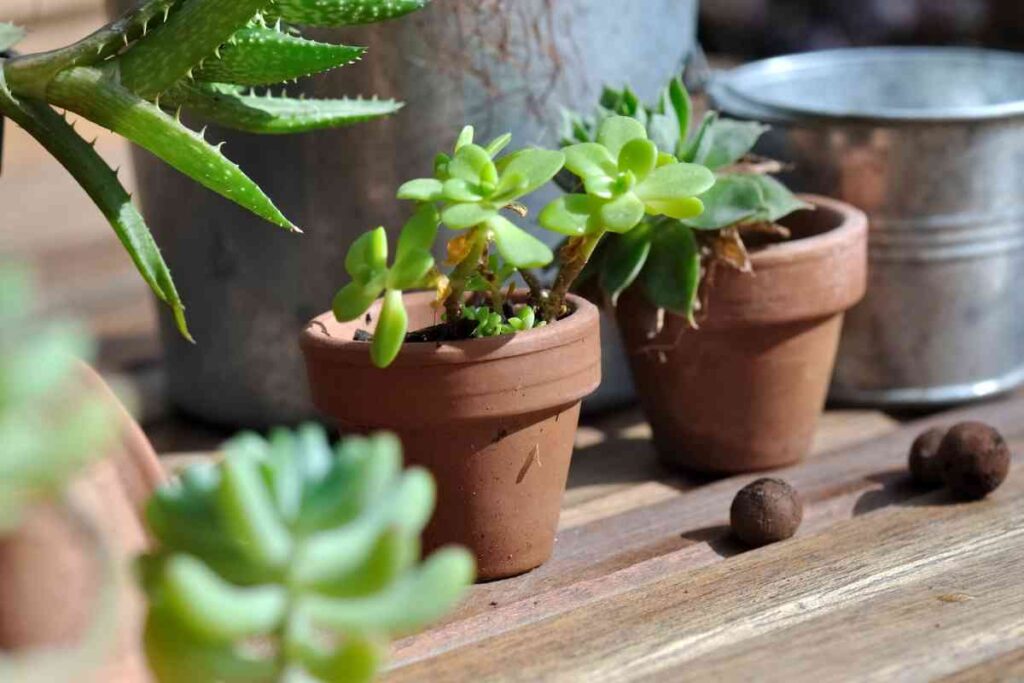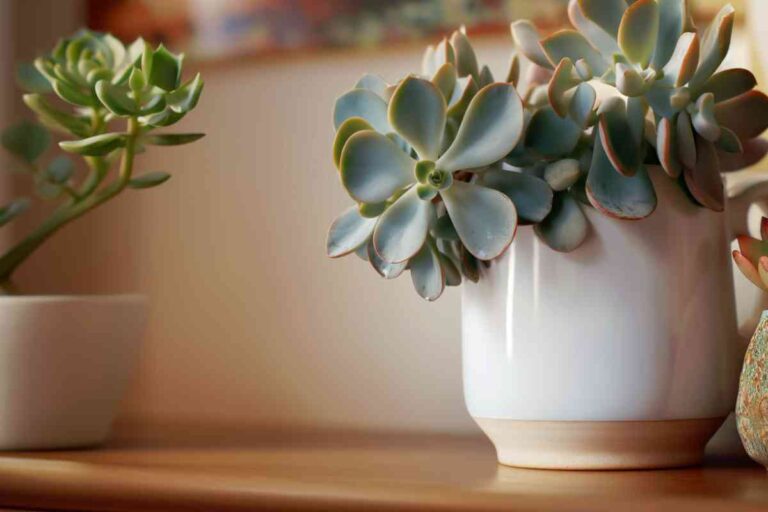Can Succulents Survive Without Roots?

Succulents are known for their ability to store water in their leaves and stems, making them drought-tolerant and low-maintenance. They can go weeks without being connected to roots.
However, roots are essential for most plants to absorb water and nutrients from the soil. So, can succulents really survive without roots?

Can Succulents Survive Without Roots?
Succulents can survive for several weeks without roots. Once they begin growing roots, they’ll need a source of water and nutrients. If kept from rooting, succulents will eventually die.
Do you have a succulent without roots? Wondering how to save it? Maybe you’d like to grow succulents with as little root ball as possible and you’re wondering how. Here’s what you need to know.
- Succulents can store water in their leaves and stems, making them low-maintenance and drought-tolerant.
- However, roots are essential for succulents to absorb water and nutrients from the soil, anchor the plant in place, and provide support to the stem and leaves.
- While some succulents can survive with minimal roots, all succulents eventually need to root to survive.
- The roots of succulents are thick and fleshy, allowing them to store water and nutrients for times when the plant cannot access them from the soil, provide support to the stem and leaves, and allow for proper aeration of the roots.
- To care for succulents without roots, it is important to let the cutting dry out for a few days before planting it in a well-draining soil mix that is specifically designed for cacti and succulents.
- The well-draining soil mix should contain perlite, coarse sand, and potting soil.
- The container for the succulent should be shallow with good drainage holes.
- After planting, water the soil thoroughly and allow it to drain completely before watering again.
Can Succulents Survive Without Roots?
The short answer is no, succulents cannot survive without roots. While they can go for extended periods without water and nutrients, they still need some form of root system to anchor them in place and provide stability.
However, some succulents can survive with minimal roots. In nature, a healthy plant growing on rocks or in sand dunes may have few roots growing. These plants have adapted to their environment by developing shallow root systems that spread out to capture moisture and nutrients.
Unlike the air plant (Tillandsia spp.), that can survive without roots, succulents eventually need to root. Air plants absorb water and nutrients through their leaves, which is why they are often seen growing on trees or rocks.

The Role of Roots in Succulents
Let’s explore the role of roots in succulents and how they contribute to the overall health and survival of these plants.
With few exceptions, roots are the foundation of any plant. They anchor the plant in the soil and absorb water and nutrients. In succulents, roots serve many additional purposes, including:
- Storing water and nutrients: Succulent roots are thick and fleshy, allowing them to store water and nutrients for times when the plant cannot access them from the soil.
- Providing structural support: The roots of succulents are often shallow and spread out, providing support to the stem and leaves of the plant.
- Facilitating aeration: Succulent roots are adapted to grow in well-draining soil, which allows for proper aeration of the roots.
While succulents can survive without roots for a short period, they will eventually die without them. The roots of succulents are essential for the plant’s overall health and survival.
Without roots, your succulent won’t be able to get water and nutrients, and they won’t have the nutrients stored in their roots either.
How to Care for Succulents Without Roots

Whether you want to propagate succulents from leaves without roots, your plant has suffered from root rot and is now without roots, or you’d like to split a larger plant into smaller pieces, it’s not hard to grow succulents without roots.
Dry Out the Succulent
When you take a cutting from a succulent, it is important to let it callous over before planting it.
This means letting the cut end of the plant dry out for a few days before placing it in soil. This will help prevent the cutting from rotting.
Succulents are adapted to dry environments and have developed strategies to survive in conditions where water is scarce. One of these strategies is the ability to form a protective layer of callus tissue over any cut or broken parts of the plant. This callus layer helps to prevent moisture loss and protects the plant from infection while it heals.
When a succulent is propagated from a leaf or a stem cutting, it’s important to wait until the cut end has formed a callus layer before planting it in soil. This callus layer indicates that the plant has healed from the cutting process and is ready to start growing new roots and shoots.

Waiting until the succulent is dry before planting it in soil helps to prevent rot and other issues. Succulents are susceptible to root rot if they are planted in soil that is too wet, so it’s important to make sure the plant is completely dry before planting it. Planting a succulent in moist soil can cause the roots to become waterlogged and can lead to rot and other issues.
Pick the Right Succulent Soil
When you have a succulent without roots, it is important to choose the right soil and container. You want to use a well-draining soil mix that is specifically designed for cacti and succulents. This type of soil will allow excess water to drain away quickly, which is important because succulents without roots are more susceptible to root rot.
To create a well-draining soil mix, you can start with a commercial cactus or succulent soil mix, or create your own by mixing equal parts of perlite, coarse sand, and potting soil.
Add a porous material like perlite or pumice to the soil mix to ensure good aeration. These materials help to create air pockets in the soil, which allows the roots to breathe and prevents soil compaction. Here are all of the ingredients you can choose from for succulent soil.
When rooting succulents, it’s important to use a shallow pot or tray with good drainage holes and fill it with the well-draining soil mix. After planting, water the soil thoroughly and allow it to drain completely before watering again. Keep the soil slightly moist, but not waterlogged, until the roots are established and the plant is actively growing.

Chose a Shallow Pot of the Right Size
I consider terra cotta to be the best type of container for succulents. Terra cotta allows air and water to move through it easily. This allows excess water to evaporate, preventing the soil from becoming waterlogged and reducing the risk of root rot. The porous nature of terra cotta also helps to regulate soil moisture levels, keeping the soil from becoming too dry.
Additionally, Terra cotta is made from natural clay, which is a non-toxic and environmentally friendly material. Unlike plastic or some types of glazed ceramic containers, terra cotta is not made from synthetic materials that can leach harmful chemicals into the soil and prevent roots growing properly.
Choose a pot just a little bigger than the succulent you want to re root.
Watering
When a succulent is growing new roots, it’s important to water it carefully to avoid damaging the delicate roots and to promote healthy growth. Succulents should only be watered when the soil is completely dry to the touch.
This is especially important when roots grow, as excess moisture can cause the roots to rot. Allow the soil to dry out completely before watering again.
When watering a succulent that is growing new roots, it’s best to water from the bottom of the pot. Fill a shallow tray or saucer with water and place the pot on top of it, making sure that the water level doesn’t reach the top of the soil.
This allows the plant to absorb water from the bottom, which encourages the roots to grow downwards in search of moisture. This ensures your new plants are strong.

Tips for Growing Succulents in Tiny Pots with Few Roots
Succulents kept permanently in tiny pots can be challenging to care for, as they have limited space for their roots to grow and may dry out more quickly than succulents in larger containers.
However, it’s easier to keep succulents healthy than other plants in tiny plants. They’re a great choice for lovely bonsai. Jade, especially, can go from a new plant to an established bonsai in months with the right environmental conditions and care.
Here’s how to care for succulent cuttings growing in tiny pots permanently.
- Soil: Use a well-draining soil mix specifically formulated for succulents and cacti. Avoid using regular potting soil, as it can retain too much moisture and lead to root rot. A good mix for succulents in tiny pots may consist of 50% coarse sand, 25% perlite, and 25% potting mix. You may want to use sphagnum moss or something else that holds more moisture if you find your tiny succulents dry out too quickly.
- Watering: Watering succulents in tiny pots can be tricky, as they can dry out quickly but also need to be protected from overwatering. Water only when the soil has completely dried out. It’s better to underwater than overwater, as succulents can survive longer periods without water than with too much water. When watering, water from below to grow roots down and avoid disturbing the leaves.
- Trimming roots: Succulents in tiny pots will outgrow their containers and need to have their roots trimmed. To do this, gently remove the plant from its pot and use sharp, clean scissors or pruning shears to trim away any dead or rotting roots. Be sure to leave plenty of healthy roots intact, as they are necessary for the plant to absorb water and nutrients. If you notice aerial roots forming, you’ll know it’s time to trim. Aerial roots mean the plant has no more room to grow roots in the pot.
- Fertilizer: Succulents in tiny pots may benefit from a small amount of fertilizer during the growing season. Use a balanced, water-soluble fertilizer diluted to half-strength, and apply once a month. Be careful not to over-fertilize, as this can burn the plant’s roots.
- Light: Succulents in tiny pots need plenty of bright, indirect light to thrive. Place them near a sunny window or under grow lights for at least 6-8 hours per day. Rotate the pot every week or so to ensure even light exposure. A grow light can help if your plant’s aren’t getting adequate light.
Overall, caring for succulents in tiny pots requires attention to detail and careful monitoring of watering and light conditions. By using the right soil mix, trimming roots as necessary, and providing adequate light and water, you can help your tiny succulents thrive and grow.

Common Problems When Growing Succulents Without Roots
When starting a succulent cutting, there are several problems that can occur. Here are some common issues to watch out for:
- Root rot: Overwatering or using a soil mix that retains too much moisture can lead to root rot, a condition in which the roots of the succulent begin to rot and decay. Symptoms of root rot include soft, brown roots and a wilted or discolored plant. To prevent root rot, use a well-draining soil mix and water sparingly, only when the soil is completely dry.
- Drying out: Underwatering can cause succulent cuttings to dry out and wilt. Symptoms of underwatering include a shriveled, dried-out appearance and brittle, brown leaves. To prevent drying out, water the cutting sparingly and provide adequate light.
- Pests: Succulent cuttings are susceptible to a variety of pests, including mealybugs, spider mites, and aphids. These pests can suck the sap out of the plant and cause wilting or discoloration. To prevent pest infestations, inspect your succulent cuttings regularly and treat any infestations promptly with an insecticidal soap or other natural pest control measures.
- Improper lighting: Succulent cuttings need bright, indirect light to thrive. If they are not getting enough light, they may become stretched out or discolored. Conversely, too much direct sunlight can scorch the leaves and cause them to turn brown. To prevent lighting issues, place your succulent cuttings in a bright, sunny location with indirect light.
- Transplant shock: When transplanting succulent cuttings into a new pot, they may experience transplant shock, a condition in which they become stressed and wilted due to the change in environment. To prevent transplant shock, be sure to acclimate your succulent cuttings to their new environment gradually, and avoid disturbing the roots as much as possible during transplantation.
By being aware of these potential issues and taking steps to prevent them, you can increase your chances of success when starting a new succulent cutting.

Conclusion
Succulents are hardy plants that can withstand drought and neglect, but they still require proper care to thrive. Even a succulent without roots can recover and thrive with patience and dedication. I love starting new plants from cuttings without roots, and I’m sure you will too!
Related Content You May Find Interesting
Here are some more articles that may be of interest to you if you’re dealing with a succulent without roots.







